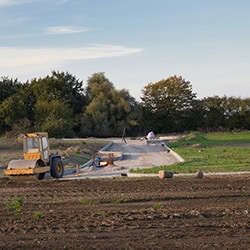
Understanding Easements vs. Right-of-Way
Easements vs. Right-of-Way: Know the Key Differences
Two terms often arise in legal discussions regarding property rights are utility easements and right-of-way. While closely related, they serve distinct purposes and have different legal implications. Understanding these concepts is crucial for landowners to navigate the eminent domain process and protect their rights.
What is an Easement?
An easement is a legal right that allows someone to use another person’s property for a specific purpose without transferring ownership. In the context of utilities, companies like Duke Energy or AT&T often require permanent utility easements to install, maintain, and repair infrastructure such as power lines, water pipes, or telecommunication cables on private land.
Easements can be categorized in several ways:
- Appurtenant vs. In Gross: Appurtenant easements benefit a specific parcel of land (e.g., access to a landlocked property), while in gross easements benefit a specific person or entity (e.g., a utility company).
- Affirmative vs. Negative: Affirmative easements allow a person to do something on the property (e.g., install a power line), while negative easements prevent certain uses (e.g., building a structure that obstructs a view).
- Express vs. Implied: Express easements are written agreements, while implied easements arise from circumstances (e.g., a property owner has used a pathway for years, suggesting an implied right to continue doing so).
In most cases involving utility companies, easements are granted in gross, meaning the right to use the property stays with the company and does not transfer to future landowners. While blocking an easement is not usually possible, you can still take critical steps to protect your interests and ensure you are adequately compensated.
What is a Right-of-Way?
Right-of-way (ROW) in eminent domain permits government entities or utility companies, such as the NCDOT, to access private property for specific purposes, such as building roads, railways, and utility corridors. A property’s right-of-way could be either private or public. Public right-of-way typically applies when a government entity needs to access a property to build or maintain a road. In contrast, private right-of-way may allow a neighbor, HOA, or utility company to cross your land for a specific reason.
The key distinction here is that right-of-way primarily refers to travel or passage. It allows access to land to go from one point to another, whether for transportation, utilities, or other purposes. The right-of-way easement might enable public or private access to areas that would otherwise be difficult to reach, such as a public road that cuts through private land.
Key Differences Between Utility Easements and Right-of-Way
Utility easements allow entities like utility companies to install, maintain, and access infrastructure such as power lines or pipelines, but they don’t always permit travel across the land. Right-of-way agreements, however, are specifically for granting passage, allowing vehicles, pedestrians, or utilities to cross a portion of land. In addition, utility easements are typically narrow in scope, and focused on tasks like maintenance or inspection. In contrast, right-of-way agreements are broader, often allowing public or specific parties to use the land for transportation, such as roads or pipelines.
Utility easements are also usually granted to specific entities and may remain in effect even if the property changes ownership. Right-of-way agreements, however, can be public or private, with public rights allowing broad access and private ones restricting access to designated individuals or entities. Generally, utility easements are also tied to a specific entity. They may transfer with that entity, while right-of-way agreements are appurtenant, meaning they stay with the property regardless of ownership changes.
Finally, the utility company is typically responsible for maintaining infrastructure in utility easements. However, maintenance duties for right-of-way agreements vary, with local governments or private entities often handling upkeep depending on the nature of the right-of-way.
Legal Implications of Both Easements and Right-of-Way
Before granting an easement or right-of-way, landowners should fully understand the terms of the agreement. Both can impact your property’s use, value, and maintenance obligations. For instance, while a utility company might need an easement to install a power line, they may also require access for routine inspections or repairs. Similarly, if a road cuts across your land, a right-of-way agreement will grant the public or specific parties the right to travel through your property.
In North Carolina, as in other states, the specifics of easements and right-of-way agreements can vary depending on local property laws. Landowners should consult with legal professionals to ensure they understand the full scope and implications of granting an easement or right-of-way.
Protect Your Property Rights with an Eminent Domain Lawyer
While utility easements and right-of-way agreements involve granting access to property, they serve different purposes. If you’re dealing with a situation where someone needs to pass through your land (for example, to build a road or install a power line), a right-of-way might be the correct legal solution. On the other hand, if someone (like a utility company) needs access for specific uses like maintenance, a utility easement may be more appropriate.
Understanding the legal differences between these two concepts is essential for protecting your property rights and ensuring that any agreements are clear, fair, and legally sound. For further guidance on easements, right-of-way, or any other land-related legal issues in North Carolina, it’s always wise to consult an experienced eminent domain lawyer at Henson Fuerst.
Contact us today by submitting a form online or calling our office at (919) 781-1107 for a complimentary consultation.
